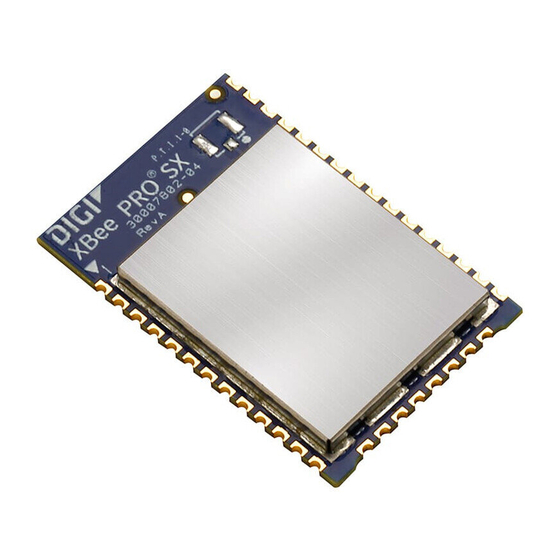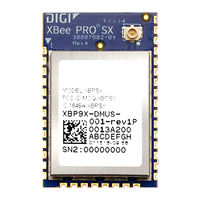
Digi Digi XBee SX Manuals
Manuals and User Guides for Digi Digi XBee SX. We have 3 Digi Digi XBee SX manuals available for free PDF download: User Manual
Digi Digi XBee SX User Manual (236 pages)
Radio Frequency (RF) Module
Brand: Digi
|
Category: Control Unit
|
Size: 2 MB
Table of Contents
-
Hardware
20 -
Kit
26 -
-
Modes
34 -
Sleep Modes
41-
Normal Mode41
-
-
Polling44
-
-
Accuracy51
-
Diagnostics54
-
-
-
Serial Data64
-
-
SPI Signals64
-
-
AT Commands
71-
-
D4 (Dio4)95
-
P3 (Dio13/Dout)100
-
P4 (Dio14/Din)100
-
-
T0 (D0 Timeout)109
-
T8 (D8 Timeout)111
-
T9 (D9 Timeout)112
-
Q0 (P0 Timeout)112
-
Q1 (P1 Timeout)112
-
Q2 (P2 Timeout)112
-
Q3 (P3 Timeout)113
-
Q4 (P4 Timeout)113
-
Sleep Commands113
-
API Frames
127-
-
AT Commands128
-
-
-
Description131
-
Format131
-
Examples132
-
-
-
Description133
-
Format133
-
Examples133
-
-
-
Description135
-
Examples135
-
-
-
Description137
-
Examples138
-
-
-
Description140
-
Examples142
-
-
-
Description144
-
Format144
-
Examples145
-
-
-
Description150
-
Examples151
-
-
-
Description152
-
-
-
Description154
-
Format154
-
Examples155
-
-
-
Description156
-
Examples156
-
-
-
Description158
-
Format158
-
Examples159
-
-
-
Description160
-
Examples160
-
-
-
Description162
-
Examples163
-
-
-
Description164
-
Examples165
-
-
-
Description166
-
Examples167
-
-
-
Description168
-
Examples169
-
-
-
Description171
-
Examples172
-
-
-
-
-
Example181
-
RSSI Indicators182
-
NACK Messages184
-
Associate LED186
-
-
Monitor I/Olines
188 -
I/O Line Passing
192 -
-
-
ERASE (0X01)198
-
READ (0X04)200
-
-
ACMA (Australia)224
-
Brazil (Anatel)225
-
IFETEL (Mexico)228
Advertisement
Digi Digi XBee SX User Manual (206 pages)
Radio Frequency (RF) Module
Brand: Digi
|
Category: Control Unit
|
Size: 2 MB
Table of Contents
-
Hardware
18 -
Kit
24 -
Modes
31 -
Sleep Modes
37-
Normal Mode38
-
-
Polling41
-
Diagnostics49
-
-
-
Serial Data59
-
-
SPI Signals59
-
-
AT Commands
64-
-
D4 (Dio4)86
-
-
T8 (D8 Timeout)101
-
T9 (D9 Timeout)101
-
Q0 (P0 Timeout)101
-
Q1 (P1 Timeout)102
-
Q2 (P2 Timeout)102
-
Q3 (P3 Timeout)102
-
Q4 (P4 Timeout)102
-
Sleep Commands103
-
SM (Sleep Mode)103
-
SP (Sleep Time)105
-
ST (Wake Time)105
-
WH Command105
-
-
-
API Frame Format112
-
API Frames115
-
-
-
Example158
-
RSSI Indicators159
-
NACK Messages161
-
Associate LED163
-
-
I/O Line Passing
168 -
-
-
ERASE (0X01)173
-
READ (0X04)175
-
-
-
ACMA (Australia)195
-
Brazil (Anatel)195
Advertisement
Advertisement


